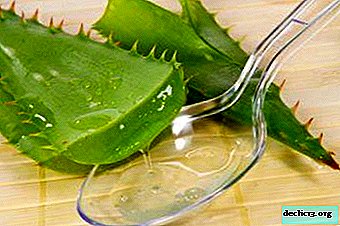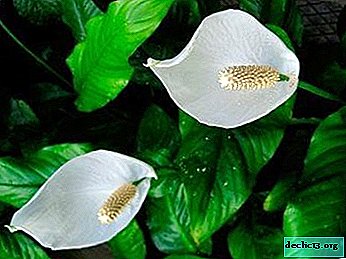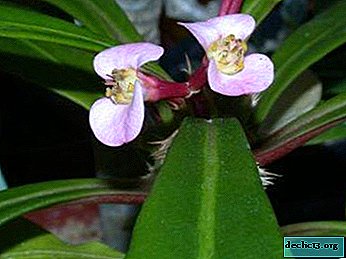Basic rules for the cultivation and care of marigolds
 Marigolds are very popular among gardeners: their flowers no longer surprise anyone. The plant is grown not only in flowerbeds and mixborders, but also in hanging baskets and pots.
Marigolds are very popular among gardeners: their flowers no longer surprise anyone. The plant is grown not only in flowerbeds and mixborders, but also in hanging baskets and pots.
However, in addition to the decorative function, marigolds also have useful properties that other flower growers are not aware of. In this article we will reveal all the secrets of the plant: consider the history, species, as well as the basic rules of growing and caring for these flowers.
Botanical description and history
Marigolds - an annual or perennial plant belongs to the family Aster or Asteraceae. A plant from America spread when the conquerors brought it to Spain in the 16th century. From there it became widespread in Russia, Asia and Europe.
The indigenous inhabitants of Mexico began to breed marigolds before the discovery of America by Europeans. The Indians believed that where marigolds grow, you can find gold. In China, the plant is considered a symbol of longevity. Hindus bring marigold flower to god Krishna.
Appearance
Marigolds have a bright specific smell, for someone seeming unpleasant. This smell is emitted to a greater extent by the leaves of the plant. Marigold leaves are separate, serrated. Their color varies from light green to dark green. The stems of the plant are erect, branched. They form a bush, which can be either compact or sprawling, with a height of 20 to 120 centimeters.
For reference. The green part of the plant is rich in ascorbic acid, and its petals contain essential oil, widely used in the perfume industry.The root system of marigolds is pivotal. Brown, yellow, orange, sometimes variegated or two-colored inflorescences of the basket are large in size (in diameter they reach 6-13 cm). They have terry, velvet petals (false-lingual flowers), which explains the Russian name of the plant.
Marigold fruit is a flattened achene of black color. Breeders managed to achieve the appearance of marigold hybrids with white flowers.
Photo
Many are interested in what this plant looks like? After all, flowers of Chernobrivtsi have become very popular in Russia, see below for a photo of the composition:





Other names
The Latin name Tagetes was given to the plant by the Swedish natural scientist Karl Linney in 1753. Tag (Tages) - Etruscan deity, born of a field furrow and possessing the mind of an old man, it had the gift of providence. At that time, the plant grew on the side of roads, so the reason for the appearance of such a scientific name is quite clear.
In England, the plant is called a phrase translated as "Mary's gold", and in Germany - "student flower" or "Turkish carnation." In Ukraine, the Tagetes are called Black-bore or Black-brow, and in Russia they are also called marigolds.Due to the fact that the petals of marigold are used as a spice, the plant is called "Imereti saffron".
Similar flowers
Although the tagetes have a peculiar appearance, some confuse them with cloves or chrysanthemum. According to the structure of inflorescences, marigolds are divided into:
- Cloves. Such flowers resemble a strict terry clove. They consist of reed petals cut along the edge.
- Chrysanthemum. Such flowers are similar to chrysanthemum, they are composed of large tubular flowers.
So, for example, the “Golden Dollar” variety of erect cloves, very similar to cloves, has large dark leaves and almost spherical clove-shaped inflorescences of red-orange color, which do not have a specific smell.
In addition, decorative marigolds are often confused with saffron. What are the similarities and differences between these two representatives of the flora, we described in detail in this article.
Benefit and harm
Both beneficial and negative effects of marigolds were noticed by the Aztecs, who used the plant for food and when performing magical rituals.
The benefits to humans
 The dried heads of this plant are used in cooking as a replacement for an expensive spice - saffron. Marigolds are also used to color food in golden color. The heady smell of tagetes will help to cope with neurosis, stress and insomnia. Also marigolds are used as:
The dried heads of this plant are used in cooking as a replacement for an expensive spice - saffron. Marigolds are also used to color food in golden color. The heady smell of tagetes will help to cope with neurosis, stress and insomnia. Also marigolds are used as:
- diuretic;
- a cold;
- sweatshops;
- laxative and in large quantities - emetic;
- anthelmintic.
You can find more information about the medicinal properties and contraindications of marigolds here, and in this article the best recipes of traditional medicine based on these plants are collected.
Marigolds are widely used as a spicy aromatic herb. Essential oils contained in inflorescences are used in the distillery, perfumery industry and in the manufacture of oriental sweets.
Plant damage
Marigolds produce a specific aroma, which according to reviews not everyone likes. Touching their flowers causes skin irritation. especially sensitive people. Gardeners do not advise planting a plant near beans and cabbage, as it will inhibit them, showing its allelopathic properties.
Plant as siderat
The plant (upright and rejected varieties) is used as siderate, that is, it enriches the soil. Marigolds are grown for about two months, then they are planted in the soil. Land enriched in this way becomes more protected from pests and weeds. The effects of the treatment last up to 6 years.
For reference. After such “green manure”, corn and barley, tulips and asters grow well on fertilized soil.From velvet, you can prepare a liquid fertilizer for garden and home flowers. This fertilizer includes bone meal and ash. The resulting mixture is rich in potassium, nitrogen and other active substances. It lowers the acidity of the soil and increases the protective barrier of plants growing on it. It is necessary to use it in a small amount, since it is possible to burn the roots of fertilized plants.
 Fertilizer from plants is done in a bucket or barrel. It is important that the tank is non-metallic. It is filled with finely chopped plants with roots and filled with rainwater.
Fertilizer from plants is done in a bucket or barrel. It is important that the tank is non-metallic. It is filled with finely chopped plants with roots and filled with rainwater.
Marigolds during their flowering frighten away pests from a flower bed, for example, nematodes, Colorado beetles, a bear. Although in extreme heat, marigolds themselves may suffer from a spider mite. Tageteses save the soil from weeds: wheat grass creeping or horsetail will not grow near them.
Variety of species
To date, 53 types of tagetes are known.. Especially popular are 3 species, which consist of many varieties and hybrids:
- Tagetes erecta L - marigolds erect ("African"). These flowers have a direct bare stalk and large inflorescences. They are grown as a cut crop on an industrial scale.
- Tagetes patula L - Marigolds rejected, or small-colored marigolds ("French"). Plants of this species are compact and have a shorter period from planting to flowering.
- Tagetes tenuifolia - marigold thin-leaved ("Mexican"). Plants of the species have thin, delicate leaves. From afar, groups of these colors look like a beautiful ball.
You will find more information about erect, deviated and thin-leaved types of marigolds, as well as about caring for them on open ground in a separate material.
The separation of varieties occurs depending on the structure of inflorescences, which are:
- cloves;
- chrysanthemum-like;
- terry;
- semi-double;
- simple.
How to care?
Heat loving marigolds bloom profusely from June until the first frost. They are unpretentious in care, but you need to follow the basic rules when growing them. The plant does not like dense and waterlogged soil. A large amount of nitrogen in it affects its ability to bloom: marigolds will be lush, bright green, but without inflorescences. It is better to plant a plant in sunny places, since it will not bloom in the shade (we wrote here about what to do if marigolds refuse to bloom).
Tagetes is a drought tolerant plant. After severe drought, it easily returns to its original state. During prolonged rains, marigold roots and flowers undergo decay.The optimum temperature for marigolds is 18-20 ° C. At minus temperatures, they die.
Tagetes are not afraid of the wind. They don’t need to specially fertilize the soil, especially they don’t need to do this in spring, otherwise marigolds will grow wildly without flowering (how to fertilize marigolds for plentiful flowering?). Agrotechnics when growing marigolds includes standard actions:
- loosening the soil;
- thinning;
- weed removal;
- pruning of faded inflorescences.
You can familiarize yourself with the features of growing marigolds in open ground here, and in this article we talked about caring for plants at home.
Propagation methods, planting and transplantation
The plant is propagated in the following ways:
 With seedsthat retain germination for 3 years (when and how to collect marigold seeds?). Seeds of undersized varieties are planted in open ground in May. To do this, make a furrow 5 cm deep in the soil, the distance between the seeds should be about 10 cm.
With seedsthat retain germination for 3 years (when and how to collect marigold seeds?). Seeds of undersized varieties are planted in open ground in May. To do this, make a furrow 5 cm deep in the soil, the distance between the seeds should be about 10 cm.The seeds are sprinkled with earth and watered. If there is a risk of frost, sprouts that appear after a week and a half are covered with non-woven material (especially for thin-leaved varieties). Sprouts dive. 2 months after planting, you can expect the flowering of tagetes.
- With seedlings. If marigolds need to bloom earlier, then in March they plant them in film greenhouses. First, for several days put the seeds on a damp cloth for germination. A groove is made in the soil with a depth of not more than 3 cm, shed with water and sown with seeds.
It is easily dusted with earth from above. Some gardeners plant Tagetes in boxes (is it possible to grow marigolds in drawers at home?). In this case, the soil is poured into boxes, at the bottom of which drainage is laid (expanded clay, sand, crushed stone) or holes are made. Fertilize it and plant sprouted seeds of tagetes. If the seedlings are thickened, then they will dive. If tall varieties are selected, then they are planted individually in separate containers immediately after a dive.
Seedlings are transplanted into the open ground after the appearance of at least three pairs of leaflets. Marigolds can be transplanted even in blooming condition. The plant tolerates the transplant well.
You will find more information on when to plant marigolds in open ground or in a pot, as well as on subsequent care of plants in a separate material.
Diseases and Pests
Although it is believed that marigold repels pests with its smell, but the plant is sometimes attacked:
- whitefly;
- snails;
- spider mite;
- slugs.
Florists will help pesticides cope with whiteflies and spider mites. If the spider mite appeared due to the heat, then the plant is sprayed several times a day with water, and then three times treated with infusion of onions or yarrow.
If the plant is attacked by slugs or snails, then you can leave the cut potato tuber for flowers at night over the flowers, which will attract pests. The next morning, the pests that attacked the tuber are collected manually. More information on how to save marigolds from pest attacks can be found here.
With waterlogged soil, the roots of the plant are exposed to fungal diseases, for example, the "black leg". Spraying with a pink solution of potassium permanganate will help to cope with it. However, it is better to remove the affected parts of the plant in order to avoid infection of healthy flowers. Read how to detect the disease and pests on marigolds and how to treat the bush, in our article, and here we talked about why the leaves of the plants wither and the buds of the plants turn black and what to do in this case.
Unpretentious marigolds delight with their bright large flowers and are a "green fertilizer" that helps to grow flowers without the use of chemicals.

 With seedsthat retain germination for 3 years (when and how to collect marigold seeds?). Seeds of undersized varieties are planted in open ground in May. To do this, make a furrow 5 cm deep in the soil, the distance between the seeds should be about 10 cm.
With seedsthat retain germination for 3 years (when and how to collect marigold seeds?). Seeds of undersized varieties are planted in open ground in May. To do this, make a furrow 5 cm deep in the soil, the distance between the seeds should be about 10 cm.















